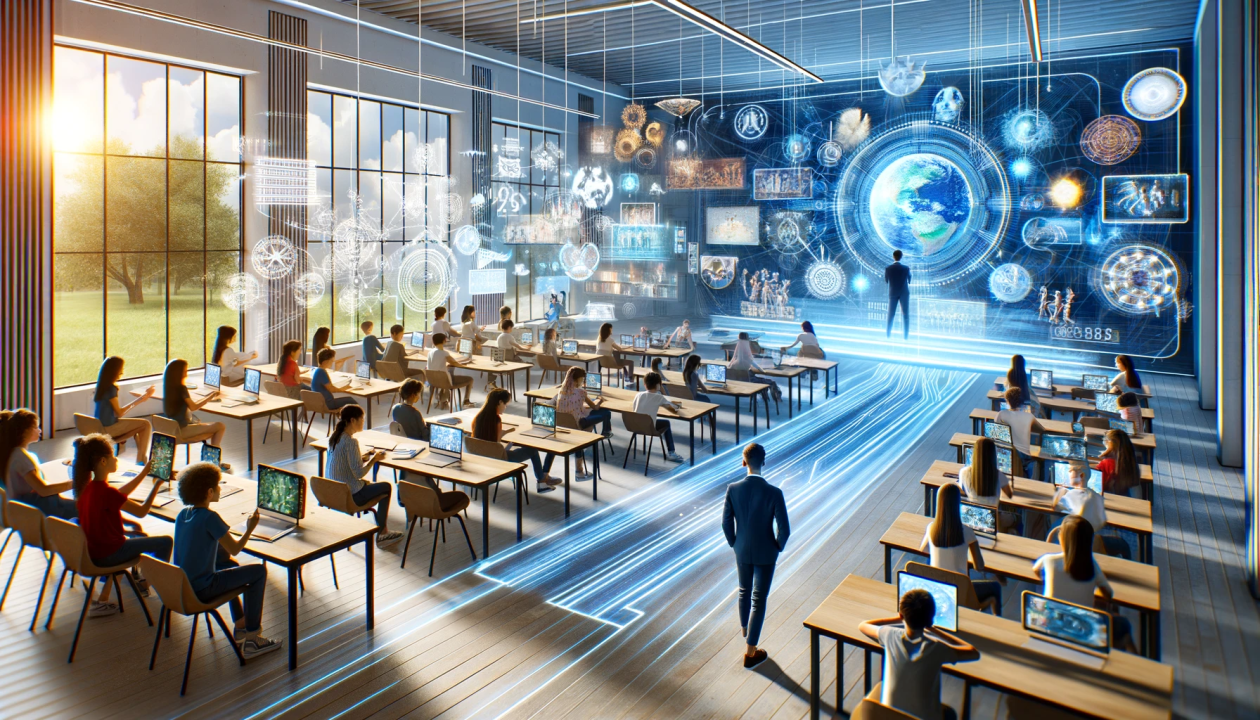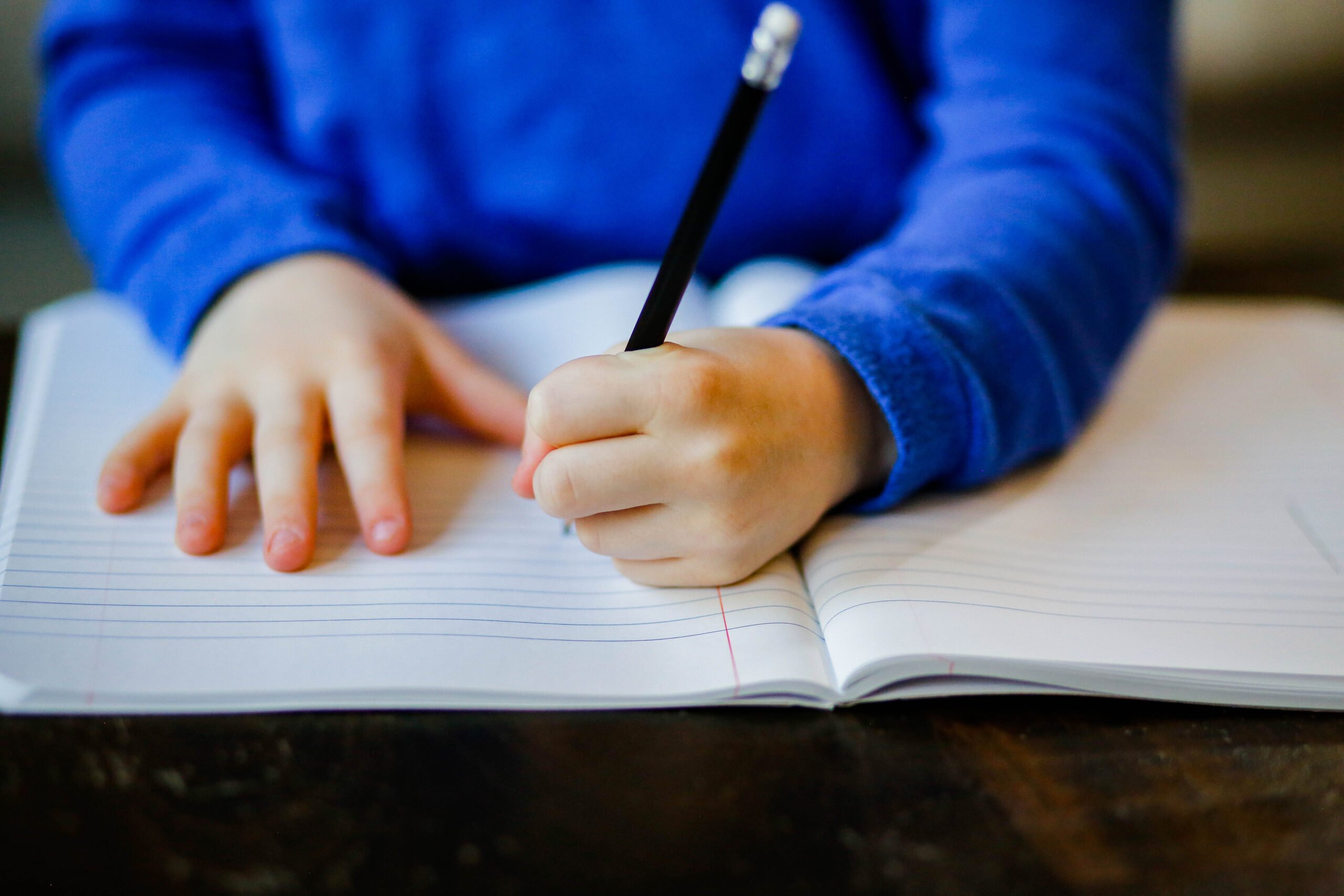
When Chris Knight started teaching in 2011, overhead projectors were being replaced by smartboards and teachers could finally project slides directly to the whiteboard from their laptops. Technology was emphasized as a utility in the classroom, said Knight. But a decade later in 2021, when in-person classes resumed after a year online, Knight noticed a big cultural shift in his classroom, one that he attributes in part to his students’ relationship to technology.
Artificial intelligence certainly wasn’t a novelty in 2021, but in the years leading up to the pandemic, AI — touted as a tool of efficiency — quickly progressed beyond spellcheck. Public access to long awaited generative AI tools like Dall-E, and the release of large language models like ChatGPT in 2022, took the world by storm and schools were not immune to these advances.
For Knight, who teaches at a high school in Albany, California, education technology used to feel thoughtful and make his life as a teacher easier. But these days, “we have this ecosystem of stuff that makes our lives as teachers actually harder,” he said, since students, with the help of AI, can forgo doing much of their own work and miss out on their own learning as a result.
However, the presence of AI might also provide something beyond efficiency: a welcome opportunity to deepen knowledge, and encourage critical thinking, according to Steve Graham, a professor of teaching and learning innovation at Arizona State University. Yet in order to reap these benefits with AI, one must apply the skills traditionally acquired from doing the hard work of learning how to read and write well. But this process is what AI can so easily bypass.
“If you’re going to be skilled at using AI for writing, you actually need to know more” than if you didn’t use AI, said Graham.
What happens when AI writes for us?
ChatGPT has raised alarms in schools since it was first released in 2022. Concerns of cheating and diminished learning were shared amongst teachers. But what happens to learning and literacy when AI writes for us?
According to Graham, reading and writing are deeply intertwined; you can’t have one without the other. Reading and writing make and communicate meaning, and they both draw upon some of the same processes in the brain, said Graham. He studies the development of writing and the effectiveness of digital tools that support writing for K-12 students.
“Reading and writing are great tools for learning,” Graham said. But when an AI tool does the “thinking” for students, such as generating large and complex portions of text, some of that learning goes away. Take an essay outline for example. Outlining a paper requires thinking about information, making decisions about what information to include and exclude, and organizing that information to make an argument, said Graham.
“If we disengage our thinking, then we’re less likely to learn as much and examine the material we’re writing about in as much depth,” he said.
According to Graham, revision is an important process of writing development and learning. “When we write, new ideas come to us…and when we revise, the same kind of thing happens,” he said. When AI tools are used to bypass some of these important steps in writing development like an essay outline or revisions, the “struggle” of learning is also taken away.
But, according to Graham, there is a right way to use AI as a “writing partner.” When you write, you make small adjustments as you go, he said. For example, you might write a sentence and wonder if you need to make a different word choice, or change the punctuation. When you use ChatGPT to suggest alternative sentences to one that you’ve already written, you are required to do “wholesale evaluations” of the material, Graham continued.
Using AI to assist with writing can become a metacognitive practice rather than a time-saving strategy. Rather than adjusting your own writing, consider using AI to generate alternative sentences. But you still need to be able to determine the “best” sentence.
“I think one of the biggest challenges for writing at high school level or any level right now is basically time. Very little time is devoted to writing,” said Graham.
Unfortunately, on a good learning day, time is tight. When time has to be used in order to address other issues in the classroom, like student apathy and learning loss, having enough time can seem like an impossibility.
The pandemic changed everything
It wasn’t until in-person classes resumed in the 2021-22 school year that Knight noticed a change in his students and the technology. “Something really didn’t work” during virtual school, he said. It wasn’t necessarily a shift in the types of technology available to students, but a shift in students’ relationship to that technology, Knight continued.
For the past four school years, Knight has witnessed his students’ social regulation skills decline. He and his colleagues now give students a five-minute break during 90-minute block periods, a practice that didn’t exist before the pandemic. And although he works hard to creatively engage his students in classroom activities, Knight often finds that they quickly blow past what he calls the “sweet spot of social engagement.” A socially engaging learning activity now quickly morphs into excess energy not conducive to learning, said Knight.
His first interaction with newer AI tech in the classroom was negative. Some of Knight’s students used ChatGPT to cheat on an essay. So Knight decided to begin using AI detection software, but the pendulum swung too far, and he falsely accused a student of cheating. The result was a damaged relationship with his student.
For the 2024-25 school year, Knight prefers paper and pencil, and doesn’t assign open-ended written response work on laptops or computers. He no longer uses AI detection software either.
Schools’ ongoing response to AI technology
Investments in technology like generative AI aren’t necessarily the only way or even the best way to improve student learning, according to Justin Reich of MIT’s Teaching System Labs. “Sometimes schools chose technology, and sometimes they chose other things,” he said.
The pandemic forced all K-12 schools, regardless of their prior technology philosophy, to aggressively adopt and adapt to extensive technological changes at lightning speed, said Reich. This accelerated the move and exposure to certain technologies before a lot of teachers and students were ready to, he continued.
And less preparation can sometimes spell a harder road to success, especially during a time of less connectivity and more social isolation.
It’s easy to spiral when thinking about the possibilities and disruptions that the advancement of AI might be capable of in the classroom. But remember, “it is quite common over the last century for people to invent technologies that bypass student thinking,” said Reich. At one point in time, encyclopedias provided a shortcut to students assigned “to summarize a topic based on multiple sources,” he said, and “calculators did the same kind of thing in math class; a more recent example might be Google Translate.”
Reich uses these earlier technological advancements that changed the culture of learning at the time they were introduced to students and teachers – but are now used quite commonly – as a reminder that “as a field, we know something about dealing with and managing technologies,” he said.
In the past couple of years, some schools have experienced high levels of students using large language models or generative AI to feed them answers to homework or essay questions. When these numbers reach a “crisis” level, and a lot of students are asking a machine to do a lot of their work without their teachers knowing, the pace of classes becomes accelerated “because the teacher thinks [students] understand stuff, but they’re just feeding him answers out of ChatGPT,” said Reich.
Where are we now?
The good news is that the AI’s predicted exponentially sophisticated growth when ChatGPT 3.5 was released has fallen flat, according to Reich. “That’s a good thing for schools,” he continued. In his conversations and surveys of students, Reich said that, in general, young people understand that they – not AI – should be doing the work. But most students agree that they use AI when they’re pressed for time, are stuck on a problem or have determined that the work that they’ve been given isn’t of value, Reich added.
Reich and his colleagues recommend that teachers encourage students to think of AI tools as helping with small portions of their work rather than assisting with the whole of their work. “So if you get stuck, don’t ask machines to do your assignment. Ask the machine to give you some help with what the next step is,” he said.
Ultimately, one solution does not fit all. Some schools and teachers, like Knight, might decide that it’s best for their learning environment and students if they return to pencil and paper, while other educational spaces adopt AI tools and discussions with students surrounding them, said Reich.
Instead of thinking about AI as an efficiency tool, Graham likes to think about AI as a means for deeper learning. “How can it help us do the things that we want to do in a way that doesn’t impede learning and is also beneficial to a broad range of kids?” said Graham. This sounds like a daunting task, but there are some reasonable ways to implement AI as a tool that both benefits the teacher and the student in the classroom and promotes learning.
For example, Graham spoke with a teacher who used ChatGPT to produce a writing sample with some of the most common miscues used by students in that class. The class looked at the AI generated “student” example and deepened their understanding of their own writing without the embarrassment of singling out an individual students’ writing.
Although it is widely understood that AI detection software isn’t reliable, AI has been shown to be pretty good at giving feedback, said Graham. This doesn’t mean that AI is better at giving feedback than humans are, but AI is able to replicate feedback that is similarly good and similarly bad to human generated feedback, Graham continued. But AI feedback gives us tools that aren’t often used when teacher feedback is given, and that is skepticism.
While some teachers give open-ended feedback to student work, other teachers give feedback that assumes the student takes that feedback directly. “I think with AI, it opens the possibility— because we’re suspicious of what it is going to say to us —to be more critical about the feedback,” said Graham, and therefore promoting an important skill for all students to have: critical thinking.





